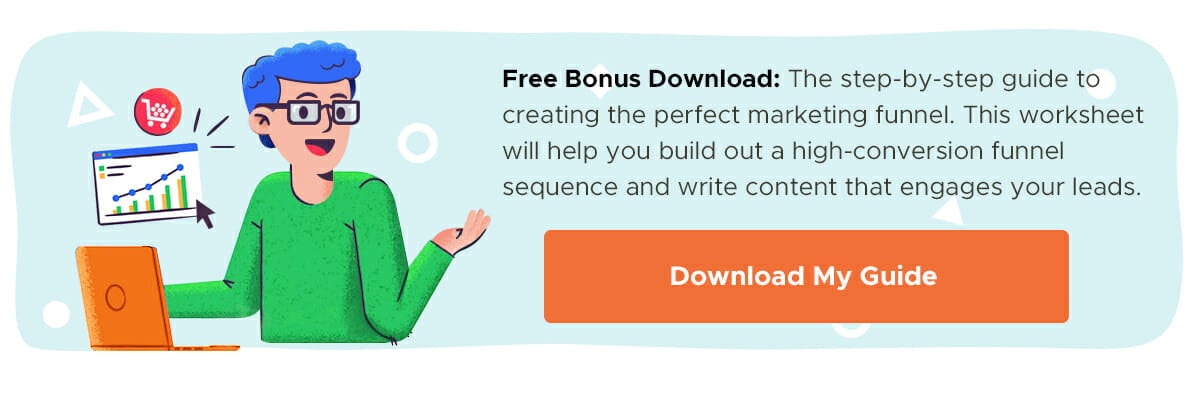Lead generation is crucial to business health. There’s no getting around that. Without a steady stream of leads flowing in the door every day, it’s hard to sustain the momentum needed for successful business growth.
But if you’ve put all the standard lead generation wisdom to work and you’re still falling short of your revenue goals, it may be time to think outside the box. If you’re ready to take your lead generation to the next level, check out the following seven unconventional strategies for generating more leads.
Strategy #1: Use a Customer Data Platform
I’ve been talking about this a lot lately, but I don’t think I’ve hammered it home enough yet: Having a customer data platform basically turns you into a marketing ninja.
If you aren’t familiar with the idea of a customer data platform, Arm Treasure Data defines it as:
“a data management solution that imports customer data from multiple sources, integrates, cleans and organizes it, and creates a unified profile of every single customer. CDPs then take that structured data and push it out to other martech platforms and web systems to enable advanced customer-centric functionality like personalization.”
In practice, all of these capabilities turn into something magical. Ten years ago, if you had said “I want to be able to find the email addresses of all the people from enterprise companies that visit my website and then drop them into different sales sequences for retargeting,” it would have sounded totally unreasonable. But now, programs like Hull and Segment are basically automating that exact process:
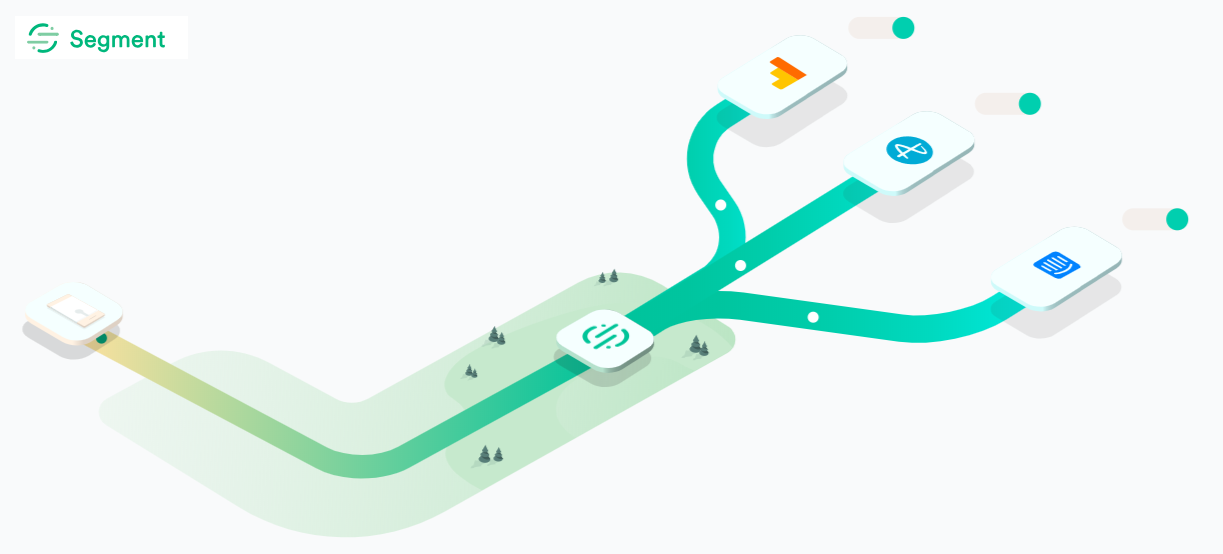
Yes, tools like these can be complicated to set up. They require some tech skills. But think about someone like Neil Patel, who’s getting seven-figure traffic each month. With a customer data platform, he’s going to be able to create so many more opportunities that other businesses will never see. You’re going to be able to really utilize the data you have, whereas most companies are just scratching the surface.
Learn More:
Strategy #2: Use Quizzes to Improve Lead Quality
When it comes to leads, quality is king. You could have thousands of leads in your funnel, but if they aren’t the right people, those numbers don’t matter. They’ll never convert customers.
To make sure you’re capturing the right leads, you need more information. But that doesn’t have to mean forcing prospects through 20 different form fields. Neil has used a tool called LeadQuizzes that makes gathering information fun, because it feels more like a quiz that visitors want to go through:
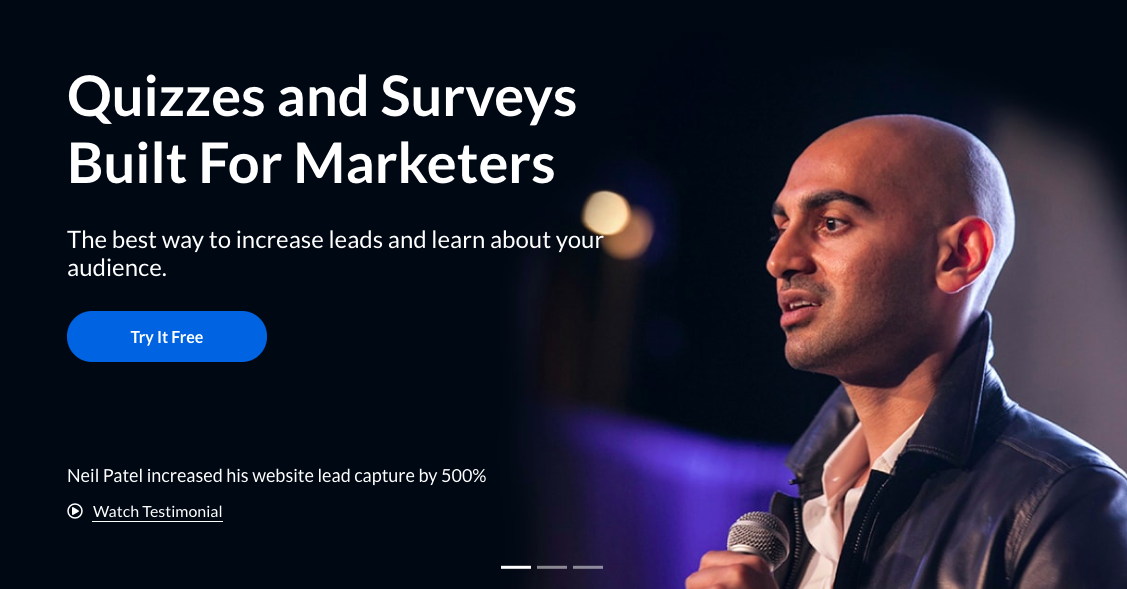
Neil has used a lead quiz as his exit pop-up, but there are plenty of different places you could use a tool like this to increase your visitor-to-lead rate. For example, you could set something like this to trigger on your pricing pages or your “Contact Us” page. If you use content upgrades on your site, you could require the completion of a quiz to access full content versions.
BuzzFeed figured out a long time ago that people love taking quizzes. Use this human tendency to improve your lead generation efforts using LeadQuizzes.
Strategy #3: Use Personalization
The benefits of personalization are pretty obvious. Do you feel better about buying from the business that treats you like a transaction, or do you want to buy from one that rolls out the red carpet and treats you like the only customer in their sales funnel?
Research on personalization backs this up. According to Business2Community:
“75% of consumers are more likely to buy from a retailer that recognizes them by name, recommends options based on past purchases or knows their purchase history.”
That said, the personalization efforts of most companies are falling short. Research from Pure360 suggests that “basic personalization fails to engage consumers in any real way. Just 8% of survey respondents said that they would be encouraged to engage with a retail brand if they addressed them by their first name. Similarly, only 7% said they would be likely to engage with a birthday email.”
If you really want to use personalization to improve your lead generation efforts, you have to use it in a way that demonstrates your deep understanding of the prospects you’re targeting.
Drift is one example of a company that gets personalization right:
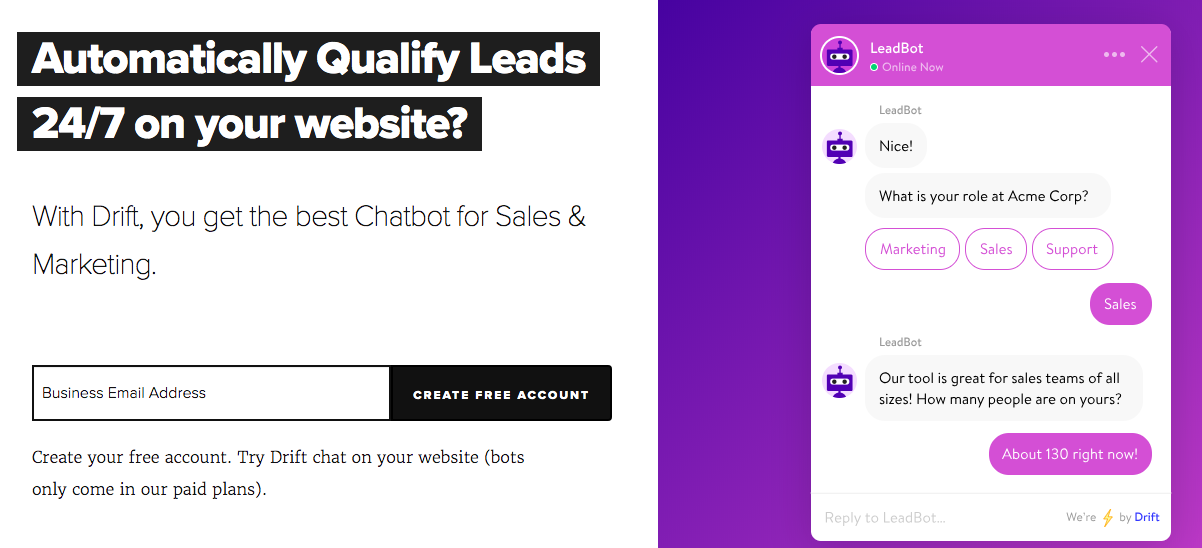
Thanks to their use of customer data platforms and other technologies, they’re able to tailor their live chat tool to the specific person visiting their website. For example, they didn’t just realize that someone from Delta Air Lines was visiting their site – they were also able to personalize their chat window to say, basically, “Hey, we help companies like Delta Airlines.”
And going back to the example of Hull, if I go to their website, I see the Single Grain logo in the middle, and the copy around it is talking about how they can help Single Grain. That’s a great feeling for me. It creates a feeling of being a little concierge-like, which makes me feel good about wanting to learn more.
Strategy #4: Use Dynamic Text Replacement
Neil has had great success with dynamic text replacement – on the level of a 10-12% conversion rate – using a tool called MaxMind to add visitors’ geographic locations to his copy.
He started with somewhat generic headline copy, which read, “Hey, I’m Neil Patel. I’m looking to help businesses grow. The only question is, will it be yours?” But using MaxMind, he was able to sub in visitors’ cities, so that the copy would read something like, “Hey, I’m Neil Patel. I’m looking to help businesses in Las Vegas, Nevada, grow. The only question is, will it be yours?”
That one little change drastically increased his lead numbers, all thanks to the level of personalization that customizing the copy to his visitors’ locations added to his site.
But dynamic text replacement doesn’t have to be that specific to work. On the Optimizely blog, Takeshi Young shares how the company tested 26 different homepage variations, each tailored to one of the company’s specific target audiences, like these three examples:
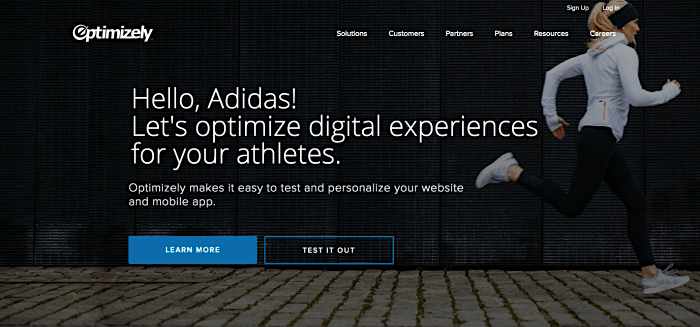
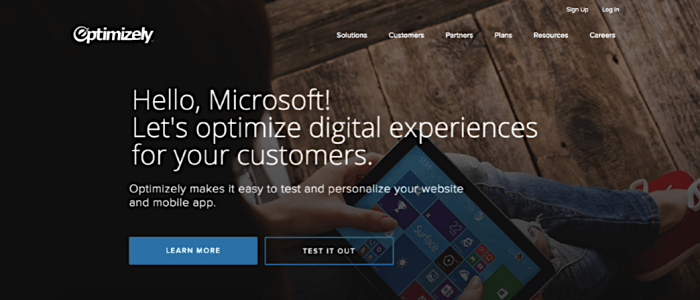
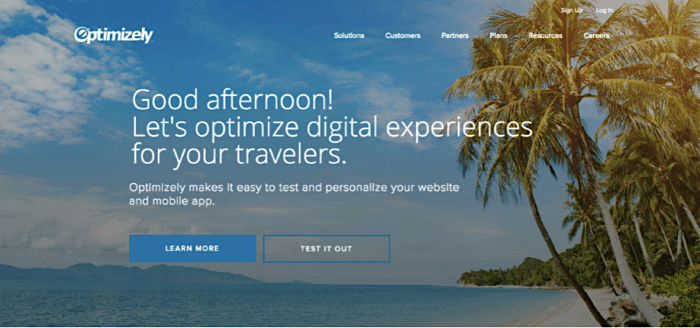
Although customizing the homepage to groups like “travelers” is hardly on the same level as Neil’s city-specific headline copy, Optimizely still saw the following results as part of its experiment:
- 1.5% increase in engagement
- 113% increase in conversions to their Solutions page
- 117% increase in conversions to the account creation process
Personalization matters. Tools like dynamic text replacement – available now through many landing page and email template builders – make a difference.
Learn More:
Strategy #5: Use Machine Learning for Lead Scoring
Lead scoring is tricky. Unless you’re an expert in the area – and unless your sales funnel is well-established and time-tested – how can you really know how to weigh specific actions or what value to assign to each?
Of course, you can test different arrangements and iterate until you find the scoring setup that will most accurately predict your success. Or you can jump the line and use machine learning to figure out how likely it is that an individual person will become a high-quality lead and, eventually, a customer.
I use MadKudu for this, in part because it integrates so well with other tools like Drift and Hull. Even if your stack looks different, it ties into so many different tools that it’s a great resource to help SaaS companies make better decisions about where they should be putting their sales and marketing resources.
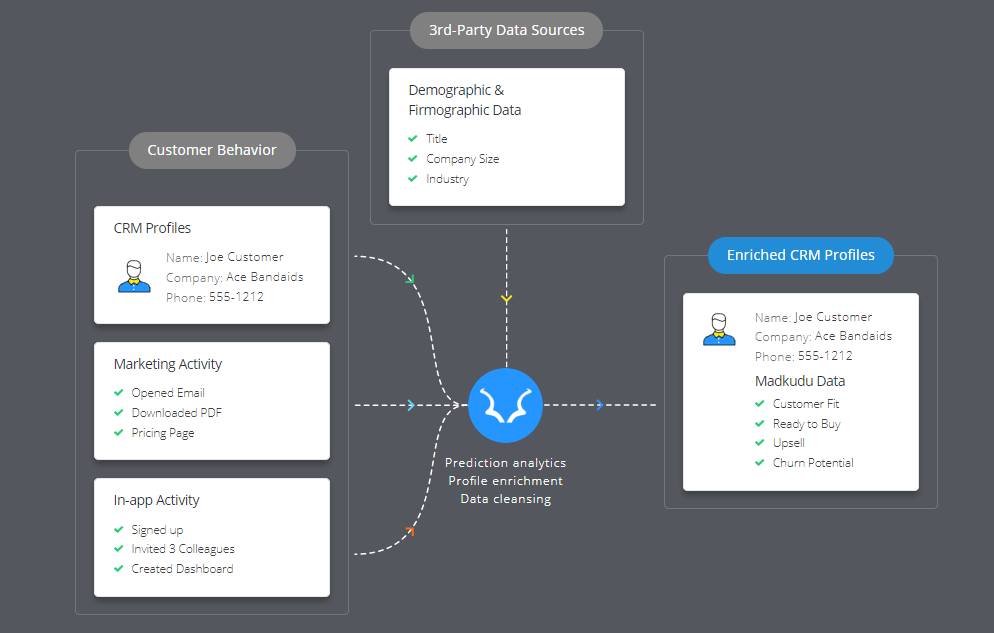
Strategy #6: Use Pre-Filled Forms
People can be lazy. Prospects even more so, because the value proposition of sharing their personal information with you isn’t always clear for them. Sure, you might solve a problem they have, but it’s also possible that they’ll end up stuck in yet another sales funnel if you aren’t the right fit.
Anything you can do to minimize the friction required to capture visitors’ personal information helps overcome this reticence, which is why I’m a fan of pre-filling peoples’ information for them. Using API services like Clearbit makes this easy, so that when visitors come to your site, half the effort of opting in is already taken care of for them:
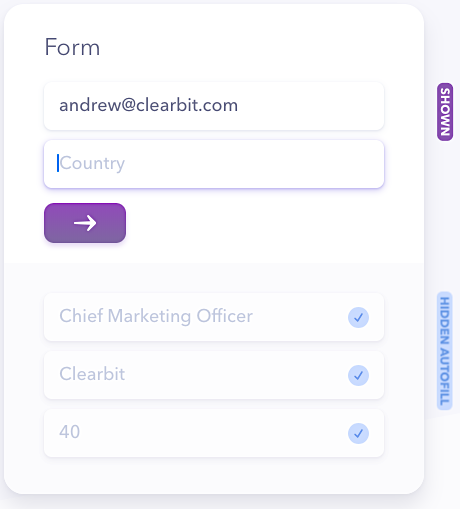
Learn More:
Strategy #7: Use Live Chat (In Some Situations)
I’ve mentioned Drift enough times already in this article that it’s worth dedicating an entire section to live chat tools. If you look at some of the trends and data points that are coming out on live chat, they’re really promising. An Invesp infographic, for example, shares that:
- 73% of customers find live chat to be the most satisfying way of communicating with a business
- 42% of customers select live chat as their preferred method of giving contact information, higher than any other lead generating method
- With a customer satisfaction rate of 92%, live chat generates more leads than phone, email or social media support
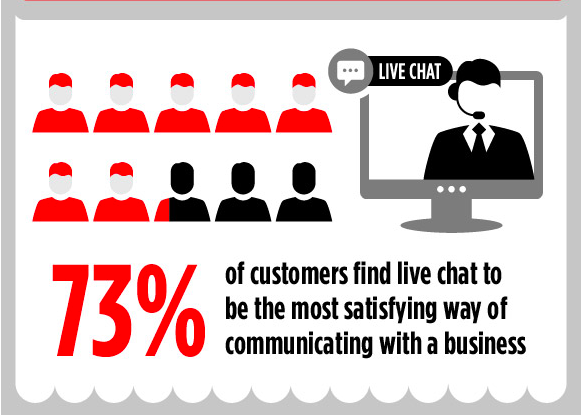
Now, as promising as these and other stats sound, I have to be transparent that both Neil and I have taken live chat off our websites. But that’s not because it doesn’t work. That’s because it’s not the right fit for every business.
At Single Grain, I’m in a high-level, high-dollar services business. When companies reach out to us regarding potential digital marketing services, that’s a very different conversation than an e-commerce shopper asking a sizing question – and it’s not one that’s likely to take place on a more informal chat channel.
If you’re in a consumer products business or any company with a more transactional focus, live chat may make a lot of sense. But even then, you have to be careful. As adoption of these tools has grown, cracks are starting to show through, especially as more businesses launch chatbots with long wait times and canned responses.
As a report by Kayako on live chat trends notes:
“Consumers want to be recognized. They want to know that a business sees them as an individual, not a ticket number – without endlessly repeating themselves.”
That’s true whether they’re connecting on live chat, by phone or over email, so don’t think of live chat as an automatic panacea for fulfilling visitors’ desire for individualized support.
There’s also a site speed angle. No live chat plugin developer is going to tell you that their tool will slow down your website. But it’s still another load on your site, so if you’re a stickler for site speed like I am, watch for changes in load times after installing live chat to make sure your site isn’t affected.
One other strategy I’ve been testing recently that I’ll share here is lead capture using MobileMonkey:
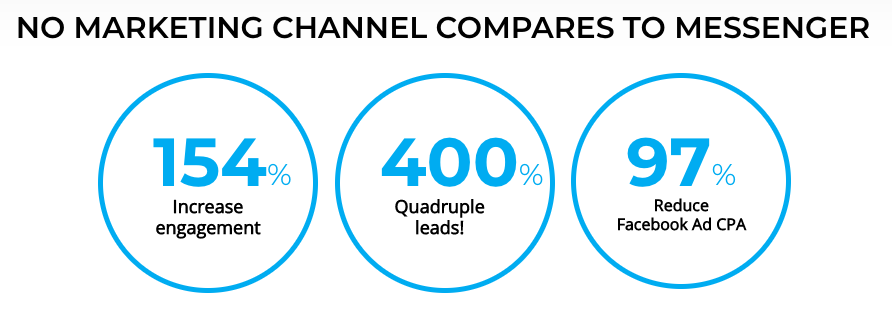
Instead of using a live chat tool like Drift, MobileMonkey uses a Facebook type of chat to collect a lead and get a new Facebook contact. Once I’ve made that connection, I can broadcast new blog post announcements and other updates to subscribers via email, push notification and Facebook messenger.
A Tech-Driven Approach to Generating More Leads
As you’ve probably noticed, most of the strategies I shared above involve using different tools to optimize the lead generating process. Given how sophisticated some of the technology entering the market is these days, I highly recommend checking out these and other tools to take some of the heavy lifting off your sales and marketing processes.
But if adding all this technology isn’t financially possible – or if setting up all these systems seems overwhelming – don’t worry. Start small. You don’t have to have a fully automated sales funnel in place right away. Pick and choose the tools that’ll make the biggest difference in your company’s lead generation flow. You can always expand as your success with individual tools drives enough revenue to fuel your future growth.
Learn More:
